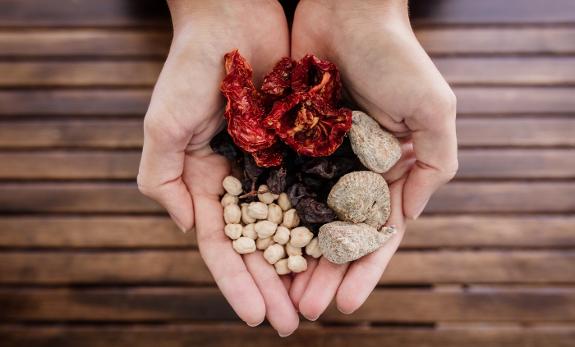

Sections
Highlight

ESPERANZA PELÁEZ
Friday, 13 September 2019, 09:52
Compartir
If water is the principle of life, it makes sense to expel it from food to help preserve it, and although the chemical processes involved in transforming a fresh protein or vegetable into a dessicated mummy were not explained until the development of science, drying is the most ancient and basic method of extending the life of foodstuffs.
For this reason, dehydration carried out by various methods (sun drying, drying in ovens or in hot sand or drying by freezing) is present in all traditional culinary cultures, sometimes complemented by salting or smoking processes to sterilise the food surface. In the Andalusian Mediterranean region, fish (including octopus), fruits (raisins, figs, peaches and apricots), vegetables (peppers and tomato) and legumes have historically been dried. Drying is perfect for preserving mushrooms and aromatic herbs. Lean meat is better because fat tends to get rancid with oxidation. For this reason, greasy meats such as cured ham and tuna are usually salted first.
The practice of drying fish is not so common nowadays, the main reason being the introduction of freezing. Also many of the species which were dried now have a higher commercial value, and it is no longer legal to sell fish that has been dried outdoors as it may be contaminated by insects and other animals as well as other sources of infection.
However, at the end of the summer in the fishermen's district of Estepona, fish can still be seen being dried on wooden frames but only for domestic consumption. In areas such as Caleta de Vélez or Marbella, dried octopus was very traditional, and the dried strips of dogfish were used by fishermen to barter for other products.
Dried white fish was a cheap and widespread food in ancient times and cod used to be also dried until salt became more popular. It was also easy to rehydrate before being cooked but was more commonly eaten as it was as drying not only produces a concentration of flavour, but also denatures the protein often bringing complexity and new aromas derived from chemical processes during the process.
In Asian culinary cultures dried tuna flakes (Japanese katsuobushi, fermentated and smoked before drying) or dried shrimp, scallops or oysters are the basis for many dishes.
Strips of dogfish can still be found in some fishmongers in the market, and they are served as an apertif in fish restaurants such as Noray and Chinchín Puerto. The growing curiosity of consumers has led to the emergence of small industries around Motril and Adra, some with online sales.
Drying fruit is less problematic than meat drying because the sugar in the flesh is also a good preservative. The best quality is obtained with sun drying, as in the case of Malaga raisins made from muscatel grapes, an excellent product in danger of disappearing, and also figs and apricots. The drying of tomatoes, peppers and aubergines, although less widespread in Malaga, has been a method of domestic conservation in areas such as the Alpujarra in Granada, where the dry climate helps.
Pulses (dried beans and peas) have been a staple of the Mediterranean diet for so long that fossilised chick peas have been found in archeoligical digs dating back to the Carthaginians. Peas and beans dry very easily in their pods on the plant but some need to be soaked in water overnight before cooking to remove indigestible complex sugars that can cause upset stomachs.
Today, thanks to domestic (electric dehydrators) or industrial drying methods, such as drum ovens or freeze-drying (quick freeze-drying, which expels water that is then extracted by vacuum), we have new dry products in our pantry, including red fruits and vegetable chips. Less romantic it may be but is at least the continuation of a practice that links us with the first beings who cooked.
Publicidad
Publicidad
Publicidad
Publicidad
Reporta un error en esta noticia
Necesitas ser suscriptor para poder votar.